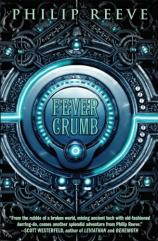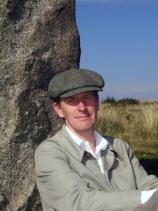Excerpt
Excerpt
Fever Crumb

PART ONE
1
The Girl From Godshawk’s Head
That morning they were making paper boys. Fever had gone down at dawn to the pressing room to collect fourteen of the big, furled sheets of paper, six feet square, which Dr. Isbister made by pulping and pressing foolish old books which his library did not need. Then she had carried them carefully back up the winding wooden stairways of the Head to the chambers which she shared with Dr. Crumb. There they had set to work.
Fever was just the right size now to lie on each sheet while Dr. Crumb drew an outline all round her with his pencil. When that was done, she fetched two pairs of paper shears, and they carefully cut out the silhouettes. Soon fourteen of her blank, white selves lay stacked on the workbench. Fever stood at Dr. Crumb’s side, watching but not speaking while he spread out one of the cutouts and laid a thin, wire skeleton on top of it. He took care over the hands, with their complicated little mechanisms, and the dim white metal discs, like flimsy coins, which were the paper boy’s eyes and brain. These were old-world mechanisms, and if they were damaged they could never be replaced, for no one knew the secrets of their making any more; they had been recycled from one generation of paper boys to the next ever since the Scriven first brought them down out of the unknown north.
When all the mechanisms were correctly positioned, Fever helped Dr. Crumb to coat the paper figure with paste. Then they took a second cutout and stuck it precisely over the first, so that the two cutouts formed a Fever-shaped paper sandwich with the metal parts hidden inside. Together, they carried it to the bath that stood in a corner of the room, and laid it in the solution. At first the paper boy just floated on the surface, like a dead leaf on a pond, but Fever took rubber-tipped tongs and gently pressed it down until the solution flowed over it and it sank. While Dr. Crumb set to work on the next paper boy, Fever got her fingers under the edge of the bath and tilted it gently up and down, up and down, so that the solution shifted but did not spill, and the paper boy slid to and fro under the surface, his head and feet banging alternately against the ends of the bath.
Fever thought that it would be more rational to call the device a paper girl, since it had been drawn around her, but Dr. Crumb said that it was not alive and had no gender.
“So why are they called paper boys?”
“A good point, Fever. The name is foolish, and was clearly not invented by a man of reason.”
When all seven paper boys had been made and soaked, they lifted them out of the bath one by one and held them up so that the excess solution could drain off. Then, carrying the dripping figures on a rack between them, they left the workroom and went up the stairs and out on to the roof.
“This is a great waste of time,” said Dr. Crumb, as they pegged the paper boys out like laundry for the brisk west wind to dry. “Why the New Council does not just ask their Master of Devices to make paper boys for them, I fail to understand. Master Wormtimber was once a member of our Order, and surely he cannot have forgotten everything he learned from us. . . .”
“Perhaps the New Council knows you make them best, Dr. Crumb,” said Fever loyally. “And maybe they want paper boys they can be sure of, if there is really to be a war.”
“There is not going to be a war,” said Dr. Crumb.
“But Dr. Isbister told me that a nomad horde is approaching from the north—”
“As our Order’s librarian, it is one of Dr. Isbister’s duties to read the city newspapers, and I’m afraid they fill his mind with rumors and scaremongery. This is not the first time one of the nomad empires has moved south. They will not dare to attack London. Though if they did, I doubt that a few paper boys could do much to stop them.”
The drying paper boys flapped and crockled, a line of white dancers strung between two ventilator cowls. Specks of rust and dust blew against them and stuck to the still-wet paper, so Fever and Dr. Crumb went to and fro patiently picking them off. After a while, as the boys began to dry, Dr. Crumb went back below, leaving Fever to keep an eye on them. She walked to the roof’s edge and lay down, enjoying the warmth of the sun. It was July, the height of London’s brief summer. Bees droned past her, and the cries of hawkers came up faintly from the deep streets, where she could see people and carts and sedan chairs moving. Jackdaws called and squabbled around the strange, old, blue metal towers in Clerkenwell; wind-trams under their clouds of sunlit sail went rattling along their spindly viaducts. And somewhere beneath her, more as a vibration in her breastbone than an actual sound, Fever could hear the voices of old Dr. Collihole and his assistants as they labored in his attic workspace, assembling the vast paper balloon in which he planned one day soon to begin the reconquest of the skies.
Fever was the youngest member of the Order of Engineers, and the only female. Engineers did not have wives or children. But one evening fourteen years before, Dr. Crumb had been called out to a dig on the Brick Marsh by an archaeologist named
Chigley Unthank who wanted an opinion on some Ancient artifacts which he’d unearthed, and on his way back he had heard crying coming from an old weed-grown pit close to the road. There, among the bramble bushes, he had found a baby in a basket with an old blanket laid over her and a label tied around her wrist upon which someone had written just four words:
HER NAME IS FEVER.
He had told Fever the story often and often when she was little. (Dr. Crumb did not believe in telling lies, not even white lies, not even to little girls. He had not wanted her to grow up thinking she was his.) She knew how he had stood there in the twilight staring down at the baby in the basket and how finally, not knowing what else to do, he had carried her back with him to Godshawk’s Head.
In earlier years he might have taken her to the civic orphanage, but that was the summer of the Skinners’ Riots, and the orphanage had been wrecked and looted, along with much of the rest of the city. In London’s rougher boroughs, like Limehouse and St Kylie, the skins of murdered Scriven still flapped like speckled flags from poles that the Skinners had set up at street corners. The collection of merchants and lawyers who called themselves the New Council had not yet completely restored order.
Dr. Crumb made up a little bed for the foundling in a spare drawer of his plan-chest and fed her watered-down milk through a laboratory pipette. Looking into her eyes, he noticed that they were different colors; the left dark brown, the right soft lichen grey. Was that why she had been abandoned? Had her mother been afraid that her neighbors would take that small oddity for a sign that the child was a Scriven or some other sort of misshape, and kill her? There was a small wound on the back of her head; a thin cut not quite healed. Dr. Crumb, who had seen for himself the savagery of the Skinners, imagined some crazed Londoner slashing at her with a knife. . . .
The other Engineers, gathering round him to peer at the tiny refugee, had all agreed with him; the child must not go back to live among those savage, superstitious Londoners. She would stay with the Order, in Godshawk’s Head, and Dr. Crumb would act as her guardian. Girls had never been admitted to the Order before, since it was well known that female minds were not capable of rational thought. But if little Fever were to be brought up in the ways of the Order from infancy, was there not a chance that she might make a useful Engineer?
So here she lay, fourteen summers later, in the sunshine on the Head’s roof. She had grown into an odd-looking girl, and her clothes made her look odder still. Only someone who had spent fourteen years being told that appearances don’t matter would dress in clothes like those. Big digger’s boots, skinny black trousers, an old grey shirt, a white canvas coat with metal buttons. Then there was her hair, or rather, her lack of hair. The Order were keen to hurry humankind into the future, and they believed that hair was unnecessary. Fever shaved her head every other morning, and had done so for so long that she didn’t remember what color her hair would be if she were to let it grow. And below the bald dome of her head she had a curious face, with a short, sudden nose and a wide mouth, thick fair eyebrows and, oddest of all, those large eyes that didn’t match. Yet somehow it all worked. It was one of those rare faces which bypassed pretty and went straight to beautiful.
Of course, that would never have occurred to Fever. She attached no importance to her looks. But she was beautiful, all the same, as she lay there watching the city and waiting for the paper boys to dry and idly tracing the raised line of that old scar that she could feel but never see — a slender silvery thread which curved along the base of her skull.
Excerpted from FEVER CRUMB © Copyright 2011 by Philip Reeve. Reprinted with permission by Scholastic Press, an imprint of Scholastic Inc. All rights reserved.
Fever Crumb
- Genres: Fantasy, Science Fiction, Young Adult 12+
- paperback: 336 pages
- Publisher: Scholastic Press
- ISBN-10: 054522215X
- ISBN-13: 9780545222150




